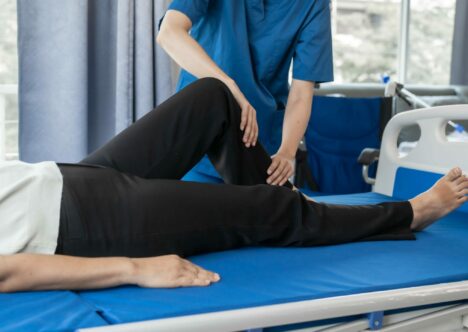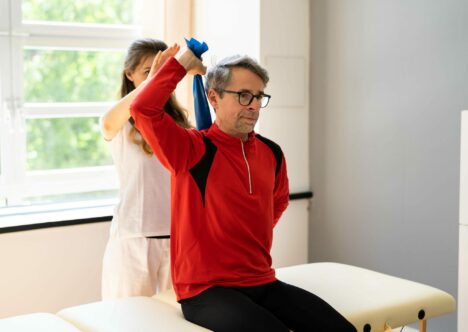Use our convenient online scheduler to book an appointment now.

For many orthopaedic injuries and surgeries, the difference between a good and poor outcome is frequently the quality of physical therapy. Unfortunately, I often find that many of my patients either don’t know how important physical therapy is to their recovery, don’t fully understand what physical therapy is or have had a bad experience with physical therapy that jaded their view about how beneficial good physical therapy can be.
To give people a better understanding of physical therapy and just how critical it can be to recovery from injuries and surgery, I thought a web-based “symposium” with a group of well-regarded physical therapists would be helpful. Over the next several months, we will post several question and answer “sessions” in which these physical therapists will answer some common questions about their important profession. I hope that you find this valuable. As always, if you have any questions, feel free to leave a question or comment here and we would be glad to include it into the conversation. Alternatively, you can contact me in my office, online or through this website and you may also reach out to our panel individually via the contact information included below.
Meet our panel:
- Chris Drew, PT, DPT – Website
- Paul Frizelle PT, DPT, MS, OCS, MTC, CSCS – Twitter
- Duncan Gerhard PT, DPT – Website, Facebook, Twitter
- Anna Marie Hammond PT, DPT, ATC – Website,
- Chris Marino PT, DPT – Website
- Robyn O’Connor PT, DPT, OCS, CSCS – Website, Facebook, Twitter
Our first question just gets into the basics. For those without much knowledge about physical therapy or who need more info about what it can do for you…
What is Physical therapy and what do you do as a physical therapist?
Chris Drew, PT, DPT:
Paul Frizelle PT, DPT, MS, OCS, MTC, CSCS:
Duncan Gerhard PT, DPT:
Physical therapy is prescribed to aid in the recovery from musculoskeletal or neurological dysfunctions. Physical therapists utilize multiple treatment techniques, including: manual/hands on treatment (stretching, message, passive joint mobilization, etc..) exercise prescription, and modalities (heat, ice, ultrasound and electrical stimulation, etc…) to decrease an individual’s pain and improve/restore their overall function. Our job as physical therapists is to approach each patient individually in an effort to help them reach their ultimate goal through treatment; as well as, educate them on how to avoid future re-injury. The idea of improving or restoring “function” can have very different meanings in different patient populations. For instance, the 13 year old, level 10, nationally ranked gymnast who is recovering from a shoulder stabilization procedure has drastically different functional requirements than her 80 year old grandmother whom is recovering from a total knee replacement. While both have the goal of decreasing their pain and returning to full function, they have very different functional requirements in their normal activities of daily living.Home exercise programs are commonly used by physical therapists and are designed to help a patient reach their goals more effectively; as well as, make them an active participant in their rehabilitation process. While in the clinic a physical therapist utilizes manual techniques such as passive stretching of muscles, joint mobilization, and massage to restore movement and decrease symptoms. While performing exercises in the clinic a therapist is able to give cues (tactile cues and verbal cues) to insure a patient is performing the exercise’s movement patterns with proper biomechanics and in a safe manner as to not re-injure or aggravate their current symptoms. A home exercise program allows for the maintenance of gains between sessions and increases a patient’s ability to successfully reach their goals. Home exercise programs are not typically a substitute or used in place of physical therapy, unless a patient has met all their goals and is set to be discharged from care.
Anna Marie Hammond PT, DPT, ATC:
Physical therapy is one of the rehabilitation branches that focuses on improving function and returning patients to their prior level of function. As a profession, physical therapists are trained to rehabilitate individuals who have had surgery, work or sports related injury, or just decreased function from another medical condition such as cancer or stroke. During your time in physical therapy, a skilled therapist will perform an initial evaluation looking at various measures that could have changed since injury such as your range of motion, strength, flexibility, balance, and movement during functional tasks such as stepping down off a step or perform a squat. All of these measures provide the therapist with deficits that are affecting your function and producing your pain. Along with the patient’s goals the therapist will design a specific exercise program including stretches, self treatment techniques, strengthening exercises, and sport specific or work related tasks. While performing these exercises you will be provided with feedback on form and technique to avoid potential injury and improve proper muscle activation.
Chris Marino PT,DPT:
I see Physical Therapy as the treatment of musculoskeletal (muscle/joint/bone) disorders through normalization of body mechanics. Pain is our body’s warning signal telling us something is not operating as it is should. When pain occurs in the musculoskeletal system, it is likely due to a specific weakness, overuse, abnormal tissue length, and/or poor alignment leading to the onset of pain. What I do as a Physical Therapist is specifically identify the cause of pain through examination of the musculoskeletal system to determine what may be the underlying cause. I then create a specific program to normalize the mobility and strength of tissues allowing for proper movement, thereby eliminating the pain. Exercising in Physical Therapy differs from regular exercise programs because they are based around specifics conditions and take your pain into consideration. Our bodies are designed to work through the path of least resistance, meaning they will do what feels easy, but not necessarily correct. By identifying poor mechanics and specific weaknesses, we can create a program that not only improves your overall strength and mobility, but will educate you on the reason the symptoms occurred in the first place, eliminate the pain, and reduce the likelihood of re-injury in the future.
Robyn O’Connor PT, DPT, OCS, CSCS:
Let me first explain what physical therapy IS NOT. It is not a place to come and solely get massaged and stretched to the point of what is considered torture. It is not where you go to come and do the same exercises everyone else in the room is doing. Physical Therapy is a functional look at the musculoskeletal system and it’s correlation of one body part to another. If you come in with back pain we are going to evaluate just more than your back and likely target other areas such as your hips, abdominals, and feet as part of the treatment. Physical therapy is guided exercise that targets the body’s imbalances in the tissues in addition to hands on care such as soft tissue mobilization, stretching and joint mobilization. Physical therapy is an individualized program to find the source of the pain and prevent future occurrence. Plus, it’s fun!
The key points here are:
Physical therapists are trained to look at your entire body as they treat the area that is in focus. They have experience and expertise in a number of specific techniques to achieve the results that we are all after. Most importantly…Physical therapy is not simply a set of exercises and cannot frequently be replaced by an exercise program done at home.
Join our Mailing List
TCO provides patients with orthopedic problems the trusted resources and patient-centered advice they need to “Feel Better. Move Better. Be Better.”
© 2024 Town Center Orthopaedics | All Rights Reserved

